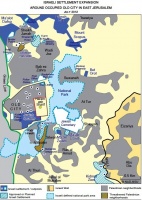- About
- News
-
Advocacy
- Accountability & Litigation
- International Advocacy
- National Advocacy
- Documentation
- FAI Unit
- Al-Haq Publications
- Library


- About
- News
-
Advocacy
- Accountability & Litigation
- International Advocacy
- National Advocacy
- Documentation
- FAI Unit
- Al-Haq Publications
- Library
On 16 February 2015, the Israeli Authorities approved a plan to build a solid waste landfill on privately owned Palestinian land in East Jerusalem. The landfill will be built on approximately 546 dunums of land between the Palestinian villages of 'Anata and Al-'Eisawiyya, East Jerusalem. Consequently, the establishment of the landfill and its infrastructure, including roads, will lead to the expulsion of 30 Palestinian families (150 people) from their homes. Adalah, along with the Civic Coalition for Palestinian Rights in Jerusalem, submitted an objection to the plan at the end of December 2012 on behalf of the 'Anata Local Council to the Jerusalem District Planning and Building Committee. This objection was denied and the plan to build the landfill was approved on 16 February 2015. In May 2014, the Israeli authorities approved a plan to build a national park on 700 dunums of Palestinian land in the towns of Al-'Eisawiyya and Al-Tur, East Jerusalem.
Insight into Al-'Eisawiyya
 The historical surface area of the village of Al-'Eisawiyya is 12,500 dunums and encompasses the area between what is now the Mishor Adumim settlement and the French Hill. It is considered a neighbourhood of East Jerusalem. Over the years, the Israeli authorities confiscated 96 per cent of its total area, leaving only 666 dunums, where some 22,000 Palestinians currently reside. Some of the lands confiscated were used for an Israeli military camp, while on other parts, the settlements of Mishor Adumim and Ma'ale Adumim, and their related infrastructure, were built. This includes a road for settlers connecting the Ma'ale Adumim settlement to Jerusalem.
The historical surface area of the village of Al-'Eisawiyya is 12,500 dunums and encompasses the area between what is now the Mishor Adumim settlement and the French Hill. It is considered a neighbourhood of East Jerusalem. Over the years, the Israeli authorities confiscated 96 per cent of its total area, leaving only 666 dunums, where some 22,000 Palestinians currently reside. Some of the lands confiscated were used for an Israeli military camp, while on other parts, the settlements of Mishor Adumim and Ma'ale Adumim, and their related infrastructure, were built. This includes a road for settlers connecting the Ma'ale Adumim settlement to Jerusalem.
Al-'Eisawiyya lacks a village master plan, and the Israeli authorities continuously reject all proposed planning suggestions by the residents to organise and increase building areas. A few years ago, the Israeli municipality of Jerusalem declared that it wanted to build a waste landfill in the area on over 500 dunums of land located in Al-'Eisawiyya, Shu'fat and 'Anata. Historically, these lands were owned by the residents of these towns and were planted with legumes. Some of the older residents even hold ownership papers for these lands dating to the British Mandate.
Abdallah Muhammad Hamdan, 71, and his ancestors have been living in Al-'Eisawiyya for 500 years. His family owns one-eighth of Al-'Eisawiyya's historic lands. Abdallah and his brothers own approximately one dunum of land in Wad Qubeila, where part of the waste landfill is supposed to be located. He recalls that when he was younger he used to cultivate this land. Following Israel's annexation of Jerusalem in 1967, farmers of Al-'Eisawiyya continued to cultivate the land. When Israelis started moving into the French Hill area, the waste from the settlement was dumped on parts of these lands, making the area unfit for cultivation. The residents attempted to set up agricultural structures on the lands but the Israeli authorities demolished them.
Since the construction of the Annexation Wall, more Palestinians have moved into Al-'Eisawiyya in order to secure their residency rights in Jerusalem. Al-'Eisawiyya has lower rent prices compared to other Palestinian neighbourhoods in Jerusalem like Beit Hanina and Shu'fat. Between 1967 and today, the number of residents in the town has increased by approximately 19,000. The increased population is severely constricted by the limited amount of fixed areas of land that are available for the construction of homes and other facilities. According to Abdallah, the conditions in Al-'Eisawiyya have become like another refugee camp in Jerusalem, where the roads are narrow, the buildings are close together, and the water, electricity, and sewage networks continuously fail as a result of the high population density. (Al-Haq Affidavit No. 10459/2015)
The Israeli authorities have kept the same master plan for Al-'Eisawiyya since 1967, leaving the younger generation of Palestinians there with doubts about their present and future in terms of housing and other basic facilities. Amin Isma'il Barakat, 50, believes that the most probable scenario for his seven children is that they would have to move out of Jerusalem once they are married, and therefore risk having their Jerusalem residency taken away by the Israeli authorities. Amin also stressed that he pays taxes to the Israeli municipality in Jerusalem, although he and the residents of the town receive no services. For example, there is no high school in the area, and elementary schools are overcrowded due to a lack of classrooms. This has led to many students dropping out, especially among the female students there. Even the cemetery is overcrowded and the Israeli authorities constantly refuse the residents' requests to build a new one. (Al-Haq Affidavit No. 10458/2015)
Legal Analysis
As noted, Al-'Eisawiyya has no village plan and the overwhelming majority of permit requests for construction are rejected. A planning system had existed under Jordanian law, which allowed for Palestinian participation in the decision-making process. However, an Israeli military order disposed of the planning committees and put the process under the control of the Israeli Civil Administration. Now, while Israeli settlers can play an active role in the planning of their illegal settlements, Palestinians in the West Bank, including East Jerusalem, have no say in the planning of their communities. Under Article 43 of the Hague Regulations which is reflective of customary international law, the Occupying Power should take all measures to “ensure, as far as possible, public order and safety, while respecting, unless absolutely prevented, the laws in force in the country.” Article 56 of the Fourth Geneva Convention similarly requires an Occupying Power to ensure public health and hygiene in the occupied territory. The landfill in Al-'Eisawiyya is a prime example of how Israel has not only amended or annulled laws that were in force prior to its occupation for its own benefit, but also how local Palestinian residents own health and livelihood have and will continue to suffer as a consequence.
According to the Land Research Centre's initial statistics for 2014, 17,433 dunums of Palestinian land were confiscated by the Israeli authorities in the West Bank, which is at its highest level in years. Israel’s actions in 2015 have shown no signs of abatement. The Israeli policy of land appropriation and its resultant settlement enterprise has a broad effect on Palestinian rights, including the right to self-determination and sovereignty over natural resources. Furthermore, Israel’s policy of land appropriation in Jerusalem, leaves Palestinians there with inadequate housing and infrastructure, forcing them to leave the city. As an Occupying Power, Israel has an obligation under international humanitarian and human rights law to protect the rights of the occupied population in the territory it occupies, including their access to private and public property. While Israel continues to facilitate the transfer of Israeli settlers, the strict construction policies and ongoing confiscation of Palestinian lands in East Jerusalem may result in the forcible transfer of the Palestinian community. Forcible transfer is considered a grave breach of the Fourth Geneva Convention and may amount to a war crime under the International Criminal Court’s Rome Statute.
